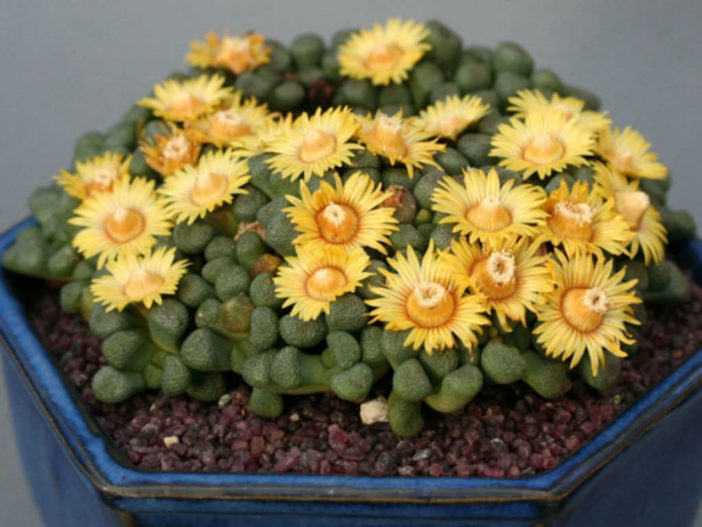Scientific Name
Aloinopsis schooneesii L.Bolus
Common Name(s)
Living Stone
Synonym(s)
Aloinopsis schooneesii var. acutipetala, Aloinopsis schooneesii var. willowmorensis, Nananthus schooneesii
Scientific Classification
Family: Aizoaceae
Subfamily: Ruschioideae
Tribe: Ruschieae
Genus: Aloinopsis
Description
Aloinopsis schooneesii is a tuberous succulent that forms dense mats of small, clustered rosettes of plump, dark blue-green, finely textured leaves with triangular tips. The leaves are up to 0.5 inches (1.3 cm) long.
The flowers are yellowish-bronze with a darker line that runs through the center of each petal, daisy-like, and up to 0.5 inches (1.3 cm) in diameter. They appear from the end of winter to the beginning of spring and open in the late afternoon or early evening.
Origin
Aloinopsis schooneesii is native to South Africa. It grows on silty flats from Willowmore to Steytlerville in the Eastern Cape province.

Hardiness
USDA hardiness zones 9b to 11b: from 25 °F (−3.9 °C) to 40 °F (+4.4 °C).
How to Grow and Care
These plants are popular among collectors. They prefer a very porous potting mix to increase drainage. Aloinopsis are winter growers and need plenty of light. Most are somewhat extremely cold-hardy and bloom in the winter.
Aloinopsis can be cultivated in the ground or in a container. They will grow in the cooler parts of the year and flower in winter if it gets good light. Direct sunlight is essential to bloom well. Aloinopsis is probably dormant in summer, so it is usually recommended not to water much in summer. Don't be surprised if they don't grow then, but although Aloinopsis are better treated as winter growers, they will grow anyway in summer if given water. They should be fertilized only once during the growing season with a balanced fertilizer.
They are propagated by seed or division. Unfortunately, Aloinopsis are prone to red spider mites and root rot.
Learn more at How to Grow and Care for Aloinopsis.
Links
- Back to genus Aloinopsis
- Succupedia: Browse succulents by Scientific Name, Common Name, Genus, Family, USDA Hardiness Zone, Origin, or cacti by Genus
Photo Gallery
Click on a photo to see a larger version.



